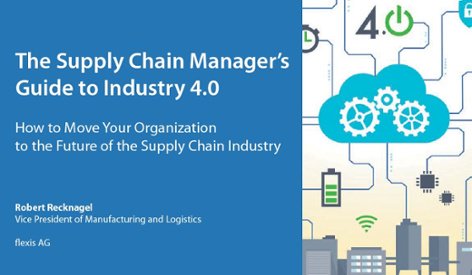What Is A Truly Digitized Supply Chain?
Nick Ostdick - May 23, 2017

 The term digitization pops up again and again as a critical value proposition for companies to leverage growth and viability in today’s manufacturing industry. The trouble is, many manufacturing companies don’t truly understand what is meant by a digitized supply chain. Is a digitized supply chain simply swapping outdated technology for the latest and greatest technological platforms? Is it merely a system of systems and solutions with the ability to communicate with each other? Or it a complete redefining of supply chain management to optimize processes and streamline planning and production strategies?
The term digitization pops up again and again as a critical value proposition for companies to leverage growth and viability in today’s manufacturing industry. The trouble is, many manufacturing companies don’t truly understand what is meant by a digitized supply chain. Is a digitized supply chain simply swapping outdated technology for the latest and greatest technological platforms? Is it merely a system of systems and solutions with the ability to communicate with each other? Or it a complete redefining of supply chain management to optimize processes and streamline planning and production strategies?
In fact, the digitized supply chain is comprised of a little of each of these statements. A completely digitized supply chain does rely on intelligent, integrated solutions rather than manual inputs or human intervention; the digital supply chain does incorporate advanced systems capable of communicating and data sharing for optimal workflows; and a digitized supply chain is a holistic reimagination of how manufacturing companies operate their supply chain management strategies from procurement to the production floor to the customer’s front door.
To better help companies understand why a digital supply network is such a crucial application in today’s manufacturing industry, we’ll examine what exactly is a truly digitized supply chain, its core elements, and the benefits for companies in a competitive, global marketplace.
Defining the digitized supply chain
Digitizing the supply chain is the movement toward a completely integrated sequence of planning and production solutions that work in tandem to create a more visible supply stream across each touch point of the value chain. The end result is a more responsive, agile, and transparent supply network that can readily adapt to a host of industry-wide unknown variables such as inventory shortages or overages, modifications to orders, and availability of resources.
Through this integration and digital transformation, companies can experience lower production and operational costs, accelerated lead times, and enhanced reporting and data analysis capabilities which can fuel better planning and production programs. To achieve these goals, companies must leverage a pervasive integration strategy that eliminates multi-suite applications and incorporates planning and reporting solutions into a single module that’s accessible and shareable across a company’s value chain.
The value proposition of a digitized supply chain in large part resides in the breaking down of cross-organization silos and collaboration barriers — two key obstacles manufacturing companies must overcome when dealing with a multitude of partners, suppliers, and production hubs or facilities in disparate parts of the world. In addition, the rise of Big Data, cloud-computing, and other data storage and management platforms, means companies will have greater data gathering, reporting, and analytics capabilities. This means companies can review and share large amounts of data in real-time to create better demand planning strategies.
Key elements of the digitized supply chain
Now that we’ve defined the digitized supply chain, we can examine and understand the concrete benefits manufacturing companies can experience by leveraging a complete digitization of their supply network. Obviously, the capability to encourage growth and enhanced productivity and profitability are important outcomes, but there are also a number of benefits such as:
Holistic integration of supply chain solutions. Because the nuances of today’s automotive supply chain are vast and varied, companies often have a number of different planning, production, and reporting/data management solutions deployed simultaneously. Creating a digital supply chain strategy requires a top-to-bottom, soup-to-nuts approach that brings each application under the same umbrella. What’s important here is the word holistic in that companies must view planning, production, and data management solutions as part of the same overall endgame rather than as disparate functions.
Connection of data sources and outlets. The Internet of Things (IOT) has become a force in supply chain management in recent years as a way of not only connecting systems and solutions, but also fostering more accurate, responsive, and accessible data management and analytics. Via the IOT, digitizing the supply chain connects various methods of collecting, sorting, and evaluating data to help planners and managers create more accurate forecasts of demand for more effective planning strategies. The connection of data sources also helps planners and managers create enhanced what-if scenarios and simulations, both of which are critical for driving planning schemes for production programs.
Improved communication and collaboration. As we mentioned earlier, digitizing the supply chain is a critical move toward eliminating communication silos across an organization. This means major players within the supply stream will have a greater capacity to share data, collaborate on important initiatives, and work in conjunction to ensure smooth workflows free of bottlenecks, disruptions, or breakdowns. Because a digitized supply chain is based in part on a central hub of data storage with multiple access points, gone are the days when those within the supply stream had to wait days or weeks to review data sets and communicate the results of said data.
The end result of the digitized supply chain?
It's something of a cliche, but today’s manufacturing industry is truly in an information age. Manufacturing companies rely on the accuracy and availability of data and reporting to create better planning platforms and production programs, but also to more effectively manage inventory, ship and track the movement of parts, and even manage personnel. The point is: A digitized supply chain is quickly becoming less of a dream and more of a necessity for companies to remain viable and competitive. The days of a silo-based supply chain are long gone.
A truly digitized supply chain is the next step for manufacturing companies companies as they look to the mid and long-term future.
LATEST POSTS
- Understand Circular Economy in The Manufacturing Industry
- How Can Industry 4.0 IT Integration Be Achieved Smoothly?
- The Significance of Order Sequencing in Discrete Manufacturing
- How to improve your Supply Chain Management: The Power of Control Towers
- Optimizing Human Resource Scheduling in Manufacturing: A Technological Approach



